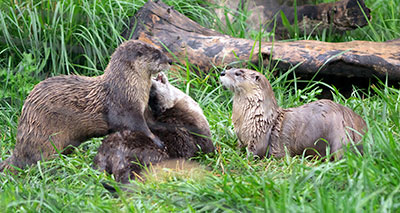North American River Otter
(Lontra canadensis)
Description & Range:
The river otter is the largest member of the weasel family (Mustelidae). It has a long, slender body covered in brown, water proof fur. On average, otters range from 36 to 50 inches long from their head to the tip of the tail. They can also weigh anywhere from 11 to 30 pounds. Otters have sharp claws on their feet to catch prey.
Otters are common throughout tidal areas of Maryland but can also be seen in other parts of the State. Otters are also abundant throughout much of the United States and Canada.
North American river otters by Dmitry Azovtsev Wikimedia CC BY-SA 3.0
http://www.daphoto.info/en/
Habitat:
River otters, despite their names, can live in a variety of habitats including streams, rivers, lakes, and freshwater and saltwater marshes. Otters prefer to live in marshes and along wooded rivers and streams with pools and overhanging rocky banks. They also will use dens made by beavers, muskrats or groundhogs.
Diet:
Otters are primarily carnivorous and will feed on fish, frogs, crayfish, shellfish, and sometimes aquatic insects, snakes, turtles, salamanders, earthworms, small birds and small mammals.
Reproduction:
River otters begin breeding at 2 years of age and mate in March-April. The young, called kits, are born the following winter/spring due to delayed implantation. River otters give birth to 2-6 young in early spring, and the young are blind until about 5 weeks of age. Kits are weaned after 4 months, and they leave the female when they reach 12-13 months old.
Behavior:
River otter are active at almost any time of the day, but tend to be most active at night. River otters are not social, but sometimes a female and her young will remain in a group. River otters regularly use latrine sites where they deposit scat, urinate, scent mark and groom. Throughout their territory, river otters will have a number of den sites which are usually leftover by beavers, muskrats or groundhogs.

River otters playing by David Ellis, Flickr CC BY-NC-ND 2.0
Management:
Annual hunting and trapping seasons for otters have been established in Maryland. River otters are managed as fur-bearing animals. To learn more about furbearer management, please click here.
Did you Know?
Otters can dive to a depth of 60 feet and can stay underwater for up to 4 minutes. With eyes adapted for underwater vision, otters are nearsighted above water. Sound, touch, and smell are very important senses that otter's use to communicate with each other.

River otter by Dan Dzurisin, Flickr CC BY-NC-ND 2.0